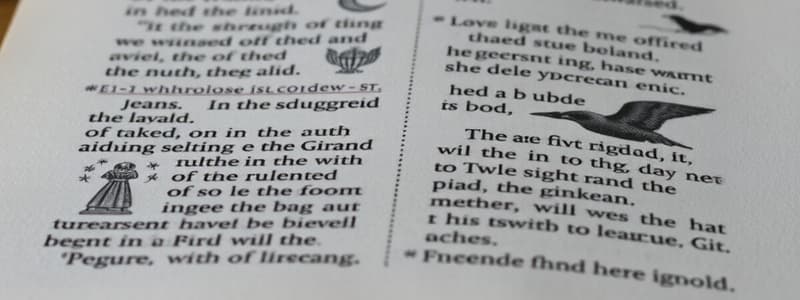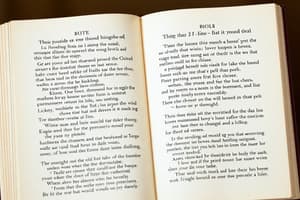Podcast
Questions and Answers
What is an example of anthropomorphism?
What is an example of anthropomorphism?
- A character speaking to a tree
- An object described with human traits (correct)
- A setting described with overwhelming detail
- A protagonist facing an internal conflict
Which of the following best describes an allegory?
Which of the following best describes an allegory?
- A narrative that focuses solely on character development
- A fictional work without any symbolic meaning
- A story where every character represents a specific idea (correct)
- A poem that utilizes over-exaggeration
What literary device is characterized by the repetition of consonant sounds at the beginning of words?
What literary device is characterized by the repetition of consonant sounds at the beginning of words?
- Assonance
- Alliteration (correct)
- Anaphora
- Ambiguity
An example of ambiguity is best described as:
An example of ambiguity is best described as:
Which term refers to the deliberate repetition of a phrase at the beginning of successive sentences?
Which term refers to the deliberate repetition of a phrase at the beginning of successive sentences?
What does assonance refer to in literature?
What does assonance refer to in literature?
Which literary device uses a series of words separated by commas without conjunction?
Which literary device uses a series of words separated by commas without conjunction?
What is the primary feature of blank verse?
What is the primary feature of blank verse?
What is the primary purpose of figurative language in writing?
What is the primary purpose of figurative language in writing?
Which term defines a character whose traits highlight the strengths and weaknesses of another character?
Which term defines a character whose traits highlight the strengths and weaknesses of another character?
What type of comedy involves one-dimensional characters in ludicrous situations?
What type of comedy involves one-dimensional characters in ludicrous situations?
Which of the following is an example of hyperbole?
Which of the following is an example of hyperbole?
What does the term 'euphony' refer to in literature?
What does the term 'euphony' refer to in literature?
Which literary device uses a warning or indication of a future event?
Which literary device uses a warning or indication of a future event?
What type of character is constructed around a single idea or quality?
What type of character is constructed around a single idea or quality?
What does 'imagery' in literature aim to create?
What does 'imagery' in literature aim to create?
What does polysyndeton emphasize in a sentence?
What does polysyndeton emphasize in a sentence?
What is a defining characteristic of a round character?
What is a defining characteristic of a round character?
Which of the following best describes situational irony?
Which of the following best describes situational irony?
What is the main purpose of using a pun in writing?
What is the main purpose of using a pun in writing?
What does the term 'theme' refer to in literary works?
What does the term 'theme' refer to in literary works?
Which of the following correctly illustrates the concept of synecdoche?
Which of the following correctly illustrates the concept of synecdoche?
What element does syntax primarily refer to in writing?
What element does syntax primarily refer to in writing?
What is a dead metaphor?
What is a dead metaphor?
What does understatement achieve in literature?
What does understatement achieve in literature?
Which of the following best defines an extended metaphor?
Which of the following best defines an extended metaphor?
What does the term 'mood' refer to in literature?
What does the term 'mood' refer to in literature?
What is an example of onomatopoeia?
What is an example of onomatopoeia?
An oxymoron is best described as what?
An oxymoron is best described as what?
What characterizes a parable?
What characterizes a parable?
Which of the following is true about a periodic sentence?
Which of the following is true about a periodic sentence?
What does personification involve?
What does personification involve?
What characterizes blank verse as used in Shakespeare's speeches?
What characterizes blank verse as used in Shakespeare's speeches?
What is the primary purpose of direct characterization?
What is the primary purpose of direct characterization?
Which of the following best defines 'climax' in a narrative?
Which of the following best defines 'climax' in a narrative?
What is the effect of using concrete language in writing?
What is the effect of using concrete language in writing?
How does connotation differ from denotation?
How does connotation differ from denotation?
What is the effect of using enjambment in poetry?
What is the effect of using enjambment in poetry?
What is a characteristic of didactic literature?
What is a characteristic of didactic literature?
Which of the following is a common feature of cacophony in writing?
Which of the following is a common feature of cacophony in writing?
Flashcards
Adage / Proverb
Adage / Proverb
A well-known saying expressing a common truth.
Allegory
Allegory
A story with a hidden meaning beneath the surface. Characters and events represent abstract ideas.
Alliteration
Alliteration
Repetition of consonant sounds at the beginning of words.
Allusion
Allusion
Signup and view all the flashcards
Ambiguity
Ambiguity
Signup and view all the flashcards
Analogy
Analogy
Signup and view all the flashcards
Anaphora
Anaphora
Signup and view all the flashcards
Antagonist
Antagonist
Signup and view all the flashcards
Climax
Climax
Signup and view all the flashcards
Cacophony
Cacophony
Signup and view all the flashcards
Conflict
Conflict
Signup and view all the flashcards
Cliché
Cliché
Signup and view all the flashcards
Concrete language
Concrete language
Signup and view all the flashcards
Connotation
Connotation
Signup and view all the flashcards
Consonance
Consonance
Signup and view all the flashcards
Diction
Diction
Signup and view all the flashcards
Euphony
Euphony
Signup and view all the flashcards
Exposition
Exposition
Signup and view all the flashcards
Farce
Farce
Signup and view all the flashcards
Figurative Language
Figurative Language
Signup and view all the flashcards
Flat Character
Flat Character
Signup and view all the flashcards
Foil
Foil
Signup and view all the flashcards
Foreshadowing
Foreshadowing
Signup and view all the flashcards
Onomatopoeia
Onomatopoeia
Signup and view all the flashcards
Oxymoron
Oxymoron
Signup and view all the flashcards
Parable
Parable
Signup and view all the flashcards
Paradox
Paradox
Signup and view all the flashcards
Parallelism
Parallelism
Signup and view all the flashcards
Periodic Sentence
Periodic Sentence
Signup and view all the flashcards
Point of View
Point of View
Signup and view all the flashcards
Polysyndeton
Polysyndeton
Signup and view all the flashcards
Pun
Pun
Signup and view all the flashcards
Repetition
Repetition
Signup and view all the flashcards
Round Character
Round Character
Signup and view all the flashcards
Simile
Simile
Signup and view all the flashcards
Situational Irony
Situational Irony
Signup and view all the flashcards
Study Notes
Vocabulary
- Adage/Proverb: A well-known saying expressing a widely accepted truth.
- Allegory: A story with a hidden meaning, where characters, things, and events represent qualities or concepts.
- Alliteration: Repetition of initial consonant sounds.
- Allusion: Indirect reference to something familiar (literary, historical, biblical, mythological).
- Ambiguity: A situation or expression with multiple possible interpretations.
- Analogy: Comparison to a parallel case to argue for a claim's reasonableness.
- Anaphora: Repetition of a word or phrase at the beginning of successive clauses or sentences.
- Antagonist: Character or force opposing the main character.
- Anthropomorphism: Giving human qualities to non-human things.
- Assonance: Repetition of vowel sounds within words.
- Asyndeton: Consecutive words/phrases without conjunctions, often emphasizing ideas.
- Balance: Sentence construction structured similarly, typically emphasizing contrast or equal importance.
- Blank Verse: Iambic pentameter without rhyme.
- Cacophony: Jarring, discordant sound.
- Characterization: Method of developing characters, either directly stating traits, or implying traits through actions/dialogue.
- Climax: Turning point or peak of intensity.
- Conflict: A struggle between opposing forces.
- Cliché: Overused idea or expression.
- Concrete Language: Descriptive language focusing on observable details rather than abstract concepts.
- Connotation: Associated ideas or feelings evoked by a word (beyond dictionary meaning).
- Consonance: Repetition of consonant sounds.
- Diction: Word choice, essential for producing specific effects.
- Didactic: Fiction or nonfiction intended to teach a lesson.
- Enjambment: Line break in poetry that continues the sense into the next line without pause.
- Euphemism: A less direct, but less offensive way to express something.
- Euphony: Pleasant-sounding language, often with a smooth rhythm.
- Exposition: Background information provided in a story.
- Farce: Comedy relying on ludicrous situations and exaggerated character traits.
- Fiction: A literary work based on imagination.
- Figurative Language: Words or phrases that describe an idea indirectly using figures of speech.
- Flat Character: Character defined by single trait or quality.
- Foil (Character): Character whose traits contrast with another to highlight the contrasted character's strengths or weaknesses.
- Foreshadowing: Hints of future events.
- Genre: Category of literary work e.g., tragedy, comedy.
- Hyperbole: Extravagant exaggeration.
- Idiom: An expression that isn't literally understood.
- Imagery: Vivid sensory details to create an impression.
- Irony: Discrepancy between expectation and reality.
- Metaphor: A direct comparison between two unlike things.
- Mixed Metaphor: Combining unclear comparisons, often illogical.
- Mood: Atmosphere or feeling of a writing piece.
- Motif: Recurring element in a work, often revealing thematic concerns.
- Motif: Recurring element contributing to theme.
- Onomatopoeia: Words that sound like their meaning.
- Oxymoron: Contradictory terms used together.
- Parable: Short story meant to teach a moral.
- Paradox: Statement that contradicts itself but may hold truth.
- Parallelism: Similar grammatical structures for emphasis.
- Persona: A character or voice adopted by an author.
- Personification: Giving human qualities to inanimate objects or ideas.
- Plot: Series of events in a narrative.
- Point of View: Perspective from which a story is told.
- Polysyndeton: Repetition of conjunctions (e.g., and, or, but).
- Protagonist: Main character in a work.
- Pun: Wordplay emphasizing multiple meanings.
- Repetition: Repeating a word or phrase.
- Round Character: Developed character with various traits.
- Setting: Time and place of a story.
- Simile: Comparison using "like" or "as."
- Situational Irony: Discrepancy between expectation and outcome.
- Symbol: Thing or event representing something else
- Synecdoche: Part representing a whole.
- Syntax: Grammatical structure of a sentence.
- Theme: Central idea explored in a work.
- Tone: Author's attitude toward material
- Understatement: Deliberately downplaying something to create effect.
Poetry Analysis
- TSPFASTT: Method for analyzing poems (title,speaker,paraphrase,figurative language, attitude,shifts,title, theme)
Studying That Suits You
Use AI to generate personalized quizzes and flashcards to suit your learning preferences.




